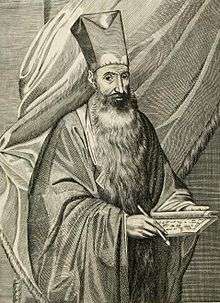Álvaro Semedo
| Álvaro Semedo | |
|---|---|
 Álvaro Semedo, from a 1655 book | |
| Born |
1585 or 1586 Nisa, Portugal |
| Died |
18 July 1658 Guangzhou, China |
| Nationality | Portuguese |
| Occupation | Jesuit missionry |
Álvaro de Semedo (Latinized form: Alvarus de Semedo; Chinese: 曾德昭, Zeng Dezhao, earlier 謝務祿 Xie Wulu) (1585 or 1586,[1] - 18 July, 1658), was a Portuguese Jesuit priest, missionary in China.
Life
Álvaro Semedo was born in Nisa, Portugal in 1585 or 1586. He entered the Jesuit novitiate in 1602, and on 29 March 1608, he left for Goa and the Far East aboard Nossa Sra. do Vencimento. He arrived in Macau in 1610, and Nanjing in 1613. Along with another Jesuit, Alfonso Vagnoni, he was imprisoned during an anti-Christian campaign in Nanjing in 1616, and then sent back to Macau, where he stayed till 1621. [1]
As the persecution campaign in the mainland China abated, Fr. Semedo changed his Chinese name from Xie Wulu to Zeng Dezhao and re-entered China, now working in Jiangsu and Jiangnan provinces. He spent most of his term in China in the central and southern provinces; perhaps his only trip north was the one he made to Xi'an in 1625, during which he was the first European to see the recently unearthed Nestorian Stele.[1]
In 1636, Semedo went back to Europe as a procurator, sent by his Order to recruit people for the China mission and to ensure continued assistance from the church in Europe. During his sojourn in Europe, he published a long report on China, best known under its Spanish title, Imperio de la China.[1]
After his return to China, Semedo served in Guangzhou (Canton) as the Vice-Provincial of the Jesuit China Mission. During several years after the fall of Beijing to the Manchus in 1644, he continued to work with the Ming loyalist regimes in the Southern China (notably, sending Michał Boym to the court of the Southern Ming Yongli Emperor),[2] even as most of Jesuits elsewhere in China were switching their loyalty to the recently established Qing Dynasty. Once the Qing took Canton, Semedo was detained, but was freed a few months later, reportedly due to the interference of Beijing-based Johann Adam Schall von Bell.[1] He spent the rest of his life in Guangzhou, where he died.
Works by Álvaro Semedo online
References
- 1 2 3 4 5 Mungello, David E. (1989). Curious Land: Jesuit Accommodation and the Origins of Sinology. University of Hawaii Press. p. 75. ISBN 0-8248-1219-0.. Mungello quotes sources for both 1585 and 1586 as Semedo's date of birth.
- ↑ Mungello, p. 139
Literature
- L. Carrington Goodrich & Chao-Ying Fang (red.): Dictionary of Ming Biography, 2 bd., New York/London: Columbia University Press 1976
External links
- Boston College. Imperio de la China : I cultura evangelica en èl, por los religios de la Compañia de Iesus. 1643